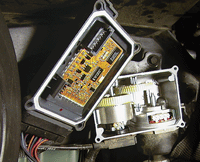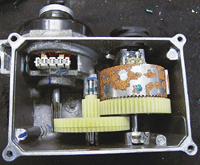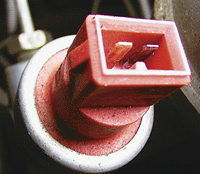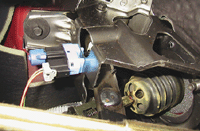Source: Motor Age
 |
| 1. Good Servo: Here’s a view of the disassembled servo-amp. For the electronics, the old-fashioned circuit board has been replaced with soft-potted space age amplifier. The old vacuum servo was supplanted by this cast aluminum assembly with a big stepper motor that pulls the cable through a network of plastic gears and an electromagnetic clutch. |
On most Ford models, vacuum-operated cruise control went the way of the dinosaurs back in 1992. The Electronic Amplifier was moved out of the passenger compartment and redesigned for work in the real world.
The workhorse that pulls the throttle open with an old-fashioned cable is a rugged stepper motor mounted in cast aluminum with an electromagnetic clutch. The clutch deactivates when the brake is pressed and the normally closed switch opens, dumping the 12-volt power to the electromagnetic field. This represents the old vacuum dump, and operates through a brake pressure switch on some vehicles and a pedal travel switch on others.
The stop lamp bulbs still provide a ground signal to the electronic amplifier that disappears if the brake or the clutch is pressed or the bulb is blown. The speed signal generally comes from the instrument cluster or the Powertrain Control Module (PCM), and the switches still provide their signal through the blue wire with the black stripe on most applications.
The amplifier almost never fails, but, in spite of its rugged design, a small amount of water intrusion can wipe out the electromechanical part of the assembly.
PowerStrokes are drive-by-wire, and have no servo; the cruise is built into the PCM.
 |
 |
 |
| 2. Water damage: This is one thing the otherwise rugged servo wasn’t designed to withstand and generally doesn’t. Moisture can make its way into the unit quite easily, and when you see this, you might as well price out a new one. It only takes a little moisture to wipe out the servo. If you can acquire one honestly, it’s a good idea to have one of these units on hand for A-B-A swaps. Use an electronic amplifier from the car you’re working on; there are subtle differences that can be misleading. | 3. Discolored Terminal: This is the brake pressure switch, which breaks the circuit to the clutch in the servo with fluid pressure applied. You’ll find it on most early-model vehicles. Note the discolored terminal; this one has failed. These also can leak brake fluid into the connector and, when that happens, the switch will fail electrically most of the time. It’s quite easy to check the operation of this switch with a test light and a helper. There is a Crown Victoria recall package (P/N XW7Z-9G652-AA) that comes with a new brake pressure switch and a connector shell, and it can be used on any vehicle equipped with one of these brake pressure switches. It’s quite handy to get both parts because sometimes the connector shell will be damaged. | 4. Cancel switch: This is the cancel switch, which does the same job as the brake pressure switch on some applications. Earlier Tauruses and Mustangs had a different type, which was more of a linear pedal travel sensor. Remember that the switch pictured here is a self-adjusting ratcheting switch, and the plunger might be shoved too far back into the switch by upward pressure on the brake pedal, causing the cruise to be inoperative. With some carefully applied force, you can ratchet the plunger back out to a position where it will close the circuit. Check to see if 12 volts is present at pin 9 on the amp with the brake pedal released. Then apply the brake to kill the voltage, and you’ll know it’s okay. |
| 5. Switch Signals: Check the reference voltage at the switch wire
(pin 5, blue/black), with the key on. This one reads 8.1 volts. You
should see anywhere from about 6 to just over 8 volts here with all the
steering wheel buttons at rest. The ON button feeds 12 volts from the
horn relay coil to pin 5, but the voltage won’t usually be a full 12
volts. Off Button: This button shorts the reference voltage at pin 5 to ground. Coast Button: Approximately 1 volt. SetButton: Approximately 3.5 volts. ResumeButton: Approximately 5.8 volts. Note: These voltages will vary down slightly when the reference voltage is lower, but you can see how the voltage steps up as you go up from “Coast” to “Resume.” |
||
| 6. Connector Pinout: While this connector pinout is for a ’96 Crown Vic, it’s a typical example of how most of them are wired (wire colors vary), and most servos will interchange for testing purposes. There are exceptions. For instance, because the later-model Mustang amps receive their speed signal from the PCM, the waveform is wrong for most other units, so if you’re doing an A-B-A swap, use the Mustang amplifier on your test servo. Later-model Windstars actually communicate through the DCL connector under the dash and toss trouble codes. PowerStrokes have no servo-amp; the PCM software does the job. | ||